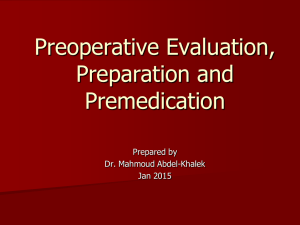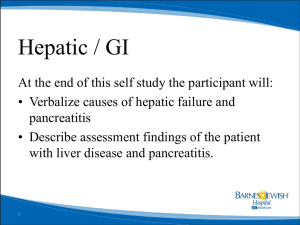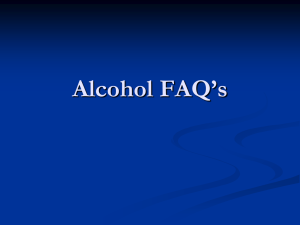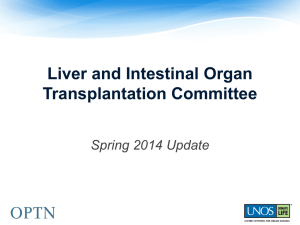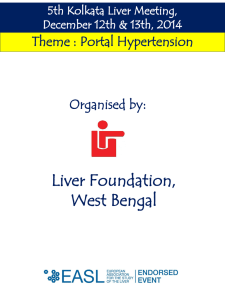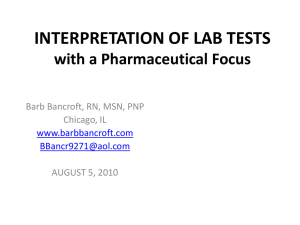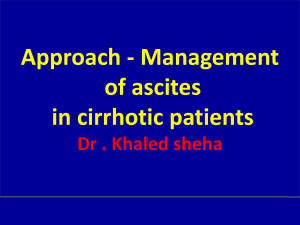Anesthesia for Liver diseased and renal disease
advertisement
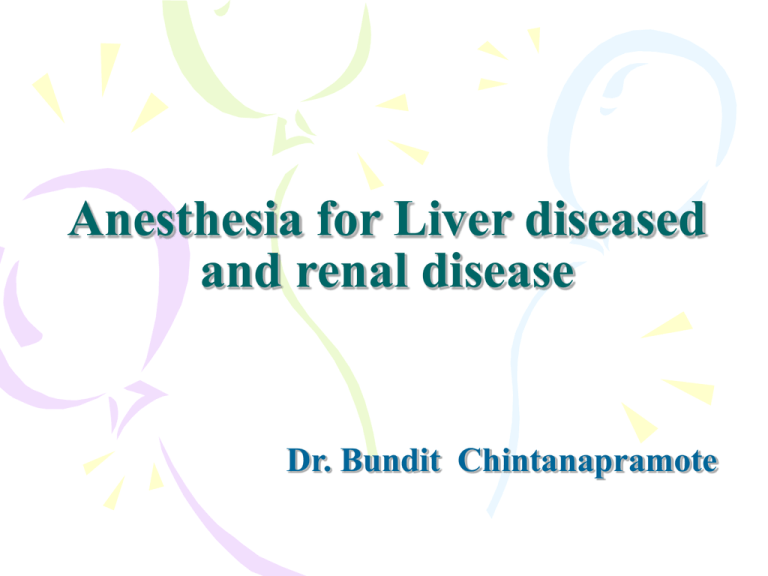
Anesthesia for Liver diseased and renal disease Dr. Bundit Chintanapramote Anatomy : Liver : wt 1500 gm (2% of BW) : Blood flow 150 ml/100 gm/min (1500 ml/min, 25% of cardiac output) : Portal blood flow 75% (Oxygenation 50%) : Hepatic artery blood flow 25% (Oxygenation 50%) Functions of the Liver 1. Metabolic • Glucose metabolism • Protein metabolism • Lipid metabolism 2. Protein synthesis • Coagulation factors II V VII X • Albumin • Pseudo cholinesterase Functions of the Liver 3. Drug metabolism • reduce albumin • increase volume of distribution • impair phase I reaction 4. Bilirubin formation and excretion • Hyperbilirubinemia (renal dysfunction replace binding site for drugs) Preoperative evaluation 1. 2. 3. 4. 5. 6. 7. Respiration system Cardiovascular system Gastrointestinal system Renal system CNS system Hematological system Metabolic and electrolyte Preoperative assessment 1. CVS • 70% develop hyperdynamic circulation • increase cardiac output (CI and HR) • decrease SVR • normal or low BP (BP = COXSVR) • rhythm disturbance from electrolyte imbalance Preoperative assessment 1. CVS • increase heart rate • down regulation of adrenergic receptors • down regulation of baroreceptors • Alcoholic cardiomyopathy Preoperative assessment 2. Respiratory system • Restrictive lung disease from ascites or pleural effusions frequently responds to fluid removal • Intrapulmonary shunts (hypatopulmonary syndrome (HPS) hypoxia occurring in the absence of ascites or intrinsic lung disease • Ventilation – perfusion (V/Q) abnormalities Preoperative assessment 3. Renal system • Salt retention due to secondary hyperaldosteronism Decrease effective circulatory volume Decrease renal blood flow Increase aldosterone Na retention, K depletion, metabolic acidosis Preoperative assessment • Hepatorenal syndrome : severe liver disease : diminish effective circulatory volume : neurohumonal factors : normal histology : urine Na < 10 mEg/L • Acute tubular necrosis • Prerenal azotemic Hepatorenal syndrome Major criteria • Chronic or acute hepatic disease and liver failure with portal hypertension • Serum creatinine level > 1.5 mg/dl or 24 hr cretinine clearance < 40 ml/min • Absence of shock, ongoing bacterial infection, recent use of nephrotoxic drugs, excessive fluid or blood loss • No sustained improvement in renal function after volume expansion with 1.5 L isotonic saline solution • Proteinuria < 500 mg/day and no ultrasonograhic evidence of renal tract or parenchyma disease Hepatorenal syndrome Minor criteria • Urine Volume < 500 ml/day • Urine Sodium < 10 mEg/L • Urine Osmolality greater than plasma osmolality • Urine red blood cell count < 50 per high power field • Serum sodium < 130 mEg/L Factor that care precipitate • Use of nephrotoxic medication (eg.) nonsteroidal anti-inflammatory drugs) • Acute gastrointestinal bleeding • Excessive diuresis • Excessive large – volume paracentesis • Infection (eg, spontaneous bacterial peritonitis sepsis Preoperative assessment 4. Hematologic system 1.1 anemia ; reduce synthesis – intake, macrocytic anemia ; reduce life span – MAHA – hypersplenism ; increase loss – esophageal varices Preoperative assessment 1.2 coagulopathy ; platelet quantitative and qualitative platelet defects (splenic sequestration, low levees of thrombopoietin from liver, sepsis bone marrow suppression, DIC (consumption) ; Vit K deficiency ; reduce synthesis of coagulation factors (check PT, PTT), factor VII (T½ 4-8 hr) ; 10% and 20% of patients with end-stage liver disease show baseline enhanced fibrinolysis Preoperative assessment 5. CNS ; hepatic encephalopathy ; ammonia level ; 90 % mortality ; GABA receptor ; cerebral edema Drug handling in liver disease 1. Biotransformation ; phase I reaction – oxidation reduction from water soluble substance (halogenated inhalation, BZP, narcotics) ; phase II reaction – conjugation to glucoronide (propofol, morphine, lorazepam, oxazepam) 2. Protein binding ; reduce albumin 3. Volume of distribution (vd) ; pancuronium Surgical risk assessment: Child’s classification as modified by Pugh Mortality Bilirubin (mg/dl) Albumin (g/dl) PT (seconds prolonged) Ascites Encephalopathy (p134) 4Nutrition Minimal (< 5%) Modest (5-50%) Marked (> 50%) <2 2-3 >3 > 3.5 3-3.5 <3 1-4 (INR < 1.7) None 4-6 (INR 1.7-2.3) Moderate >6 (INR > 2.3) Marked None Excellent PT = prothrombin time. INR = international normalised ratio. Grades 1and 2 Grades 3and4 Good Poor Effects of anesthesia on the liver 1. Liver blood flow Ventilation ; spontaneous, IPPV, PEEP Hypoxia ; vasoconstrict, sympathetic stimulation Carbon dioxide ; normocarbia Surgery Drugs ; Volatile anesthetics ; IV anesthetic ; regional block Effects of anesthesia on the liver 2. Liver blood flow Volatile anesthetic ; halothane hepatitis IV anesthetic agents ; no effect Anesthetic agents 1. Premedication short acting benzodiazepine : lorazepam, midazolam avoid sedative in severe ascites encephalopathy 2. Induction normal dose except hepatic encephalopathy rapid sequence induction Anesthetic agents 3. NMB Prolong effect pancuronium, vecuronium, rocuronium Suxamethonium Suitable for tracium, cisatracurium 4. Opioids avoid morphine alfentanyl Anesthetic agents 5. Inhalation agent avoid N2o in severe ascites halothane reduce liver blood flow causing halothane hepatitis Isoflurane, sevoflurane, desflurane can be used safely Anesthetic drugs in liver failure Drugs safe in liver failure Premedication Lorazepam Induction Muscle relaxants Propofol, thiopental, etomidate Desflurane, sevoflurane, isoflurane, nitrous oxide Atracurium, cisatracurium Opioids Remifentanil Analgesics Paracetamol Maintenance a Drugs to be used with caution (may Need reduced dosage) Midazolam, diazepam Drugs contraindicated in liver failure Enflurane Halothane (possibly)a Pancuronium, vecuronium, suxamethonium Fentanyl, alfentanil, morphine, pethidine NSAIDs, lidocaine, bupivacaine Halothane has been rarely reported to cause hepatitis (see p143). Causes of postoperative liver dysfunction or jaundice Bilirubin overload (haemolysis) Blood transfusion Haematoma resorption Haemolytic anaemia (sickle, cell, prosthetic heart valve, glucose-6-phosphatase deficiency) Hepatocellular injury Exacerbation of pre-existing liver disease Hepatic ischaemia: hypovolaemia, hypotension, cardiac failure Septicaemia Drug-induced (antibiotics, halothane) Hypoxia Viral hepatitis Cholestasis Intrahepatic (benign, infection, drug-induced, e.g. cephalosporins, carbamazepine, erythromycin) Extrahepatic (pancreatitis, gallstones, bile duct Injury) Congenital Gilbert’s syndrome Renal disease Sign and Symptoms of TURP syndrome • Cardiopulmonary Hypertension Bradycardia Dysrhythmia Respiratory distress Cyanosis Hypotension Shock Death • Hematologic and renal Hyperglycinemia Hyperammonemia Hyponatremia Hypoosmolality Hemolysis / anemia Acute renal failure Death • Central nervous system (CNS) Nausea / vomiting Confusion / restlessness Blindness Twitches / seizures Lethargy / paralysis Dilated / non reactive pupils Coma Death Sign and Symptoms of acute hyponatrcmia Serum Na (meq/L) CNS EKG pattern 120 Drowsy Restlessness Wide QRS complex 115 Wide QRS complex Disoriented Nausea, Vomiting ST segment eleviated 110 Convulsion Coma Ventricular tachycardia Ventricular fibrillation Risk factors for perioperative ARF Pre-existing problem Perioperative Drugs Trauma Surgery Intra-abdominal hypertension Urinary obstruction Renal compromise, diabetes, Advanced age Sepsis, hypotension/hypovolaemia, dehydration Nephrotoxins: antibiotics, NSAIDs, ACE inhibitors, lithium, chemotherapy agents, Radiological contrast media Rhabdomyolysis (myoglobinaemia from Crush injuries) Biliary surgery in the presence of obstructive jaundice (hepatorenal syndrome) Renal and abdominal vascular surgery Any cause of abdominal distension Anesthetic drugs in chronic renal failure Drugs safe in CRF Premedication Induction Maintenance Muscle relaxants Opioids Local anaesthetics Analgesics Lormetazepam, midazolam, temazepam Propofol, thiopental, etomidate Isoflurane, desflurane, halothane, propofol Suxamethonium, atracurium, cisatracurium Alfentanil, remifentanil Bupivacaine, lidocaine Paracetamol Drugs safe in limited or reduced doses) Drugs contra-indicated in CRF Ketamine sevoflurane Enflurane vecuronium, rocuronium Pancuronium Fentanyl, morphine Pethidine NSAIDs




